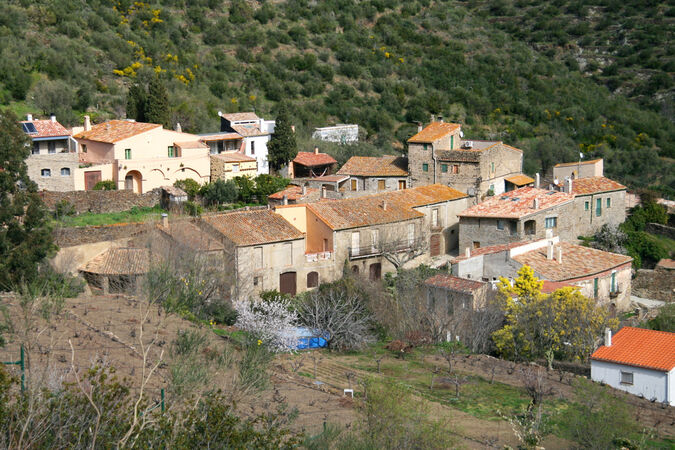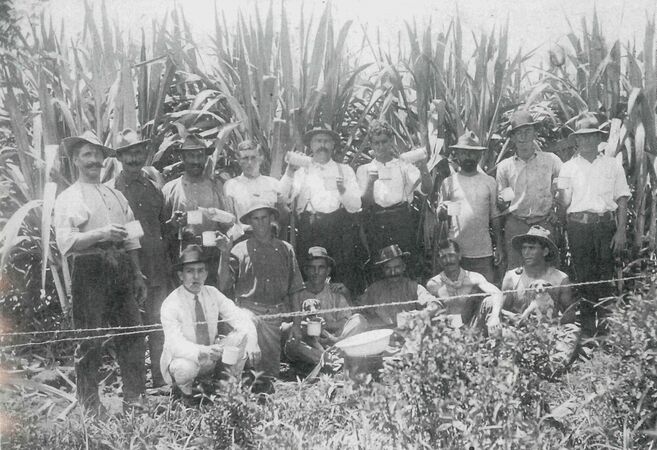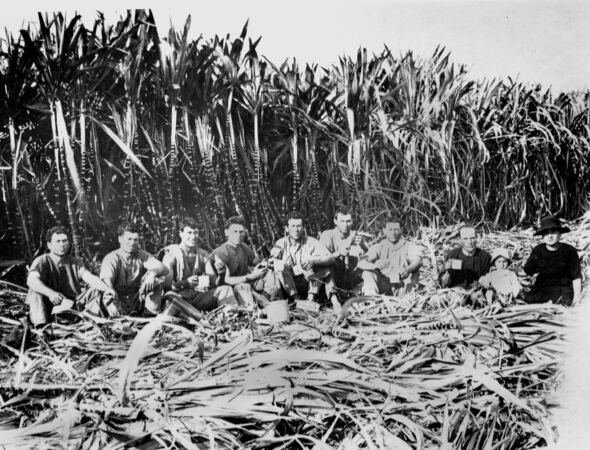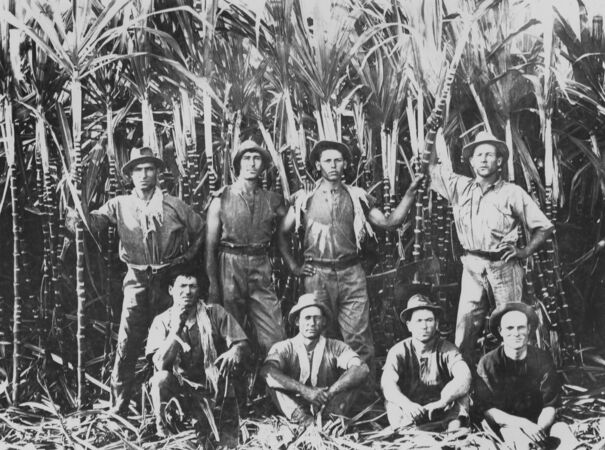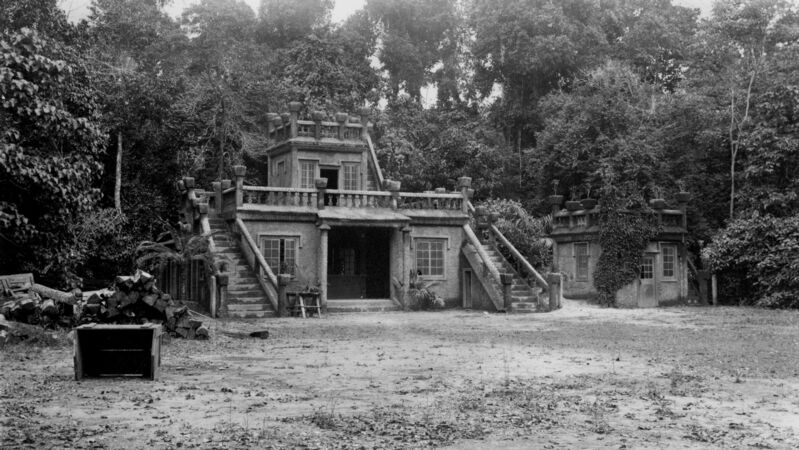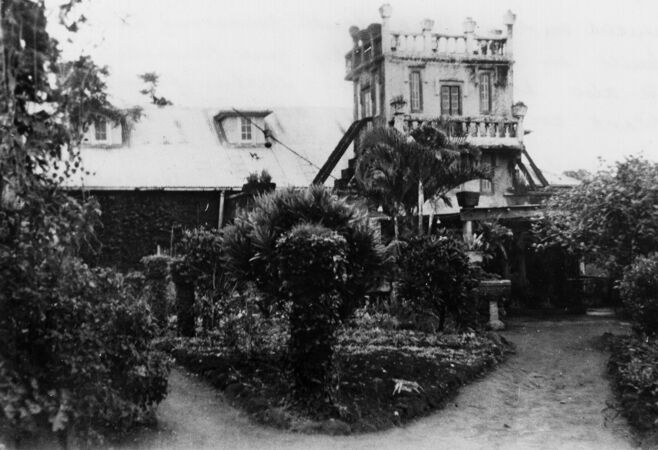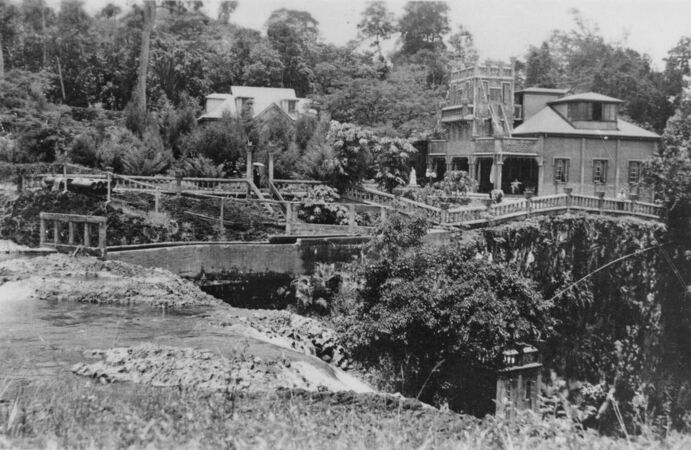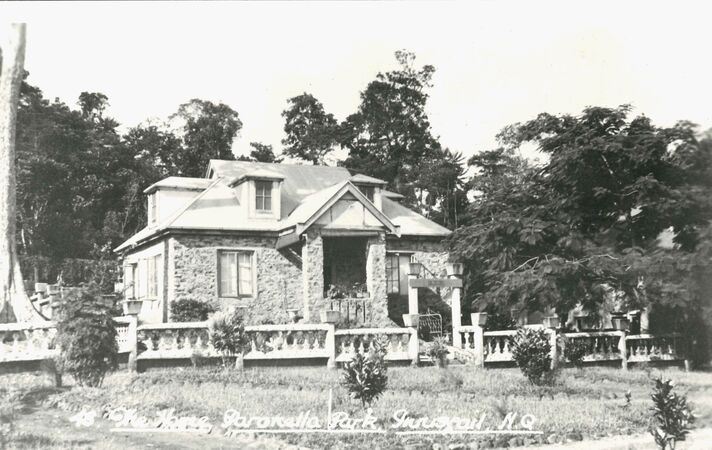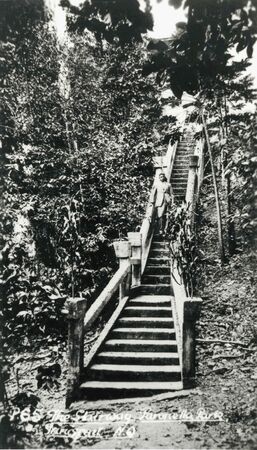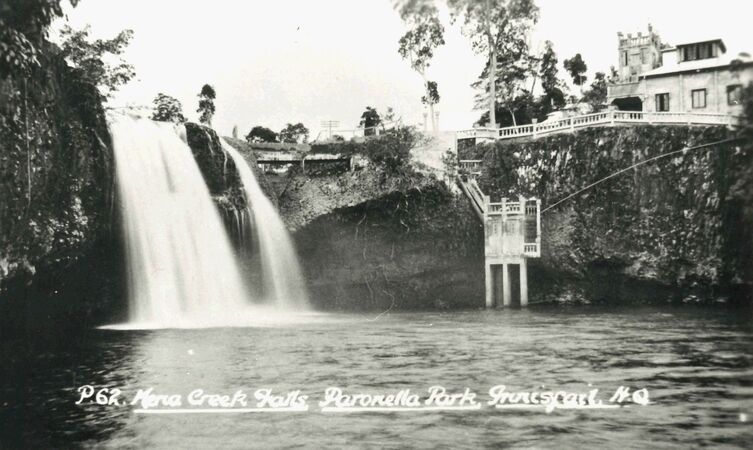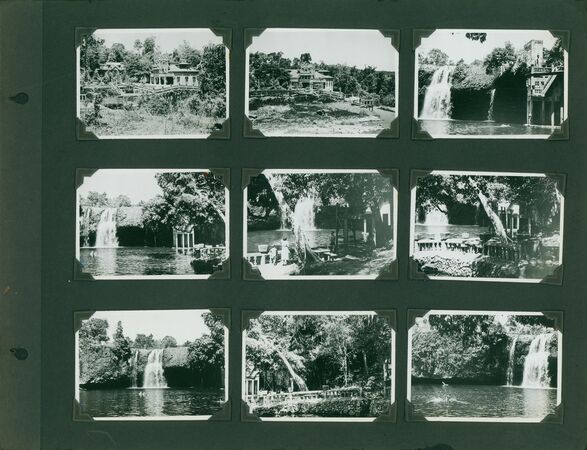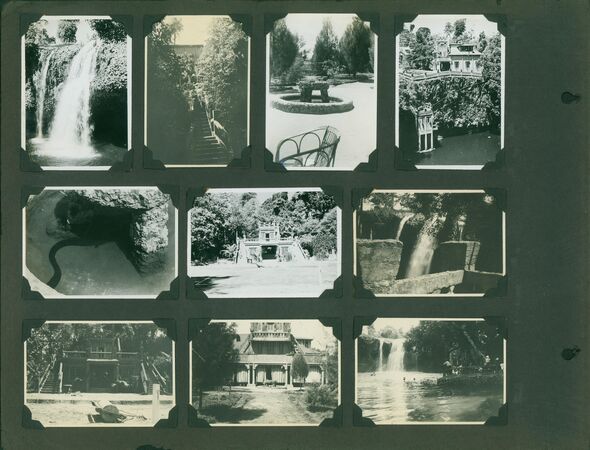Paronella Park: the story behind Queensland’s Spanish Castle
By Troy Keith, A/Coordinator Research | 17 February 2025
Paronella Park is one of Queensland’s top tourist attractions, but how did a Spanish-style castle come to be in the lush Mena Creek rainforest near Innisfail? The story behind it is just as extraordinary as the place itself—a tale of a poor Spanish immigrant who, through hard work and determination, built a fortune in Far North Queensland. A visionary dreamer, he used his wealth and resourcefulness to turn his dreams into reality.
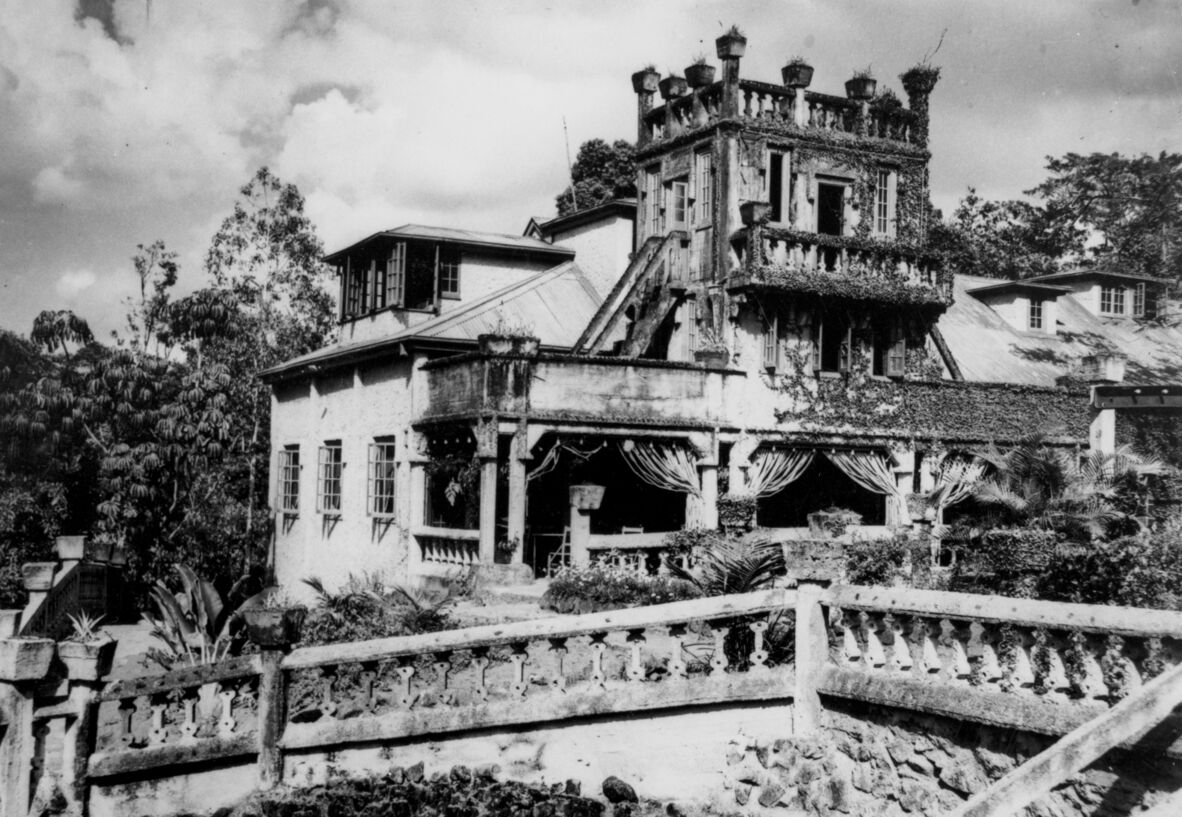
'Paronella Park' castle at Mena Creek, Queensland, 1948. John Oxley Library, State Library of Queensland, Negative number: 110320
José Paronella: From Catalonia to the Cane Fields of Queensland
In the small Catalonian village of La Vall de Santa Creu, José Pedro Enrique Paronella was born on 26 February 1887, the youngest of six children. Life in the village was simple but tough—men worked the olive groves, women tended the home and livestock, and families made do with what little they had. José’s childhood became even more difficult when his mother, Maria, died after a miscarriage, leaving the family to struggle without her.
With few opportunities at home, José left school early to find work. He first joined his married brother in a nearby town, working in a bakery, but a small house and tensions between them pushed him to seek a fresh start in the Spanish city of Pamplona. Before leaving, his father arranged his marriage to Matilda Soler, a neighbour’s daughter—a binding custom in Catalan culture. But José had other plans. In Pamplona, he embraced his independence, working, socialising, and, for a time, putting his marriage promise aside.
It was in a Pamplona café that José first saw an advertisement for work in Australia—labourers were needed for railway construction. He never answered the advertisement, but the idea of migration took root. Letters from friends also painted a picture of high wages and new opportunities abroad. With war looming in Europe, Jose made a bold decision. He withdrew his savings, sent word to Matilda, and boarded the ship Seydlitz to Sydney, arriving on 24 July 1913.
José’s stay in Sydney was brief. On the ship, he heard tales of fortunes to be made in Queensland, where miners were striking it rich, so he sailed north. His first stop was the copper mines of the Selwyn Ranges near Cloncurry. The work was hard, the heat unbearable, and the living conditions rough. After four months, José’ had enough, he left the mines and returned to the coast, searching for something better.
By early 1914, José found himself in the cane fields of South Johnstone. The work was relentless—blistered hands, searing heat, and swarms of insects. Yet he was determined to set himself up. Jose joined the cane-cutting gangs, where many of his fellow workers were Spanish and Italian immigrants, men who, like him, had come from large families scraping a living from the land. Used to long hours and high temperatures, they adapted quickly to Queensland’s demanding conditions.
José, however, was not just a labourer—he had a sharp mind for business and dreamed of owning his own Cane Farm. He worked hard, saved diligently, and watched how the farms operated. The cane fields may have been gruelling, but they were also an opportunity. And José was just getting started.
From peasant to prosperity
José Paronella’s skills as a baker landed him a job as a cook for the cane gang—an easier, equally lucrative role than cutting cane. From a makeshift kitchen with no running water, he prepared three meals daily, ensuring the workers stayed fuelled. While others spent their wages on drinking and gambling in Innisfail, José saved his earnings, determined to build a future for himself and his future wife, Matilda, who was still in Spain.
Inspired by Spaniards and Italians who had prospered in Australia, he set his sights on land ownership. Buying his first plot of virgin rainforest in 1913, José cleared the dense vegetation by hand, planted sugar cane, and sold the farm for a profit. Over the years, he repeated this cycle, improving and selling a dozen farms, amassing a fortune.
Seeking new opportunities, José turned to mining, purchasing a tin lease in the Atherton Tablelands. He worked the mine himself, employing labourers, including local Aboriginal workers. He also lent money to fellow Spaniards and Italians eager to buy farms, growing his wealth through interest.
By 1921, at 34 years old, José was a wealthy man. He applied for naturalisation and became an Australian citizen, but his ambitions stretched far beyond farming and mining. He had a dream. When he was a small boy, his grandmother had told him stories about castles, and when he worked in Pamplona, he had seen several for himself. He wanted to build his own Spanish castle here in the Queensland rainforest. He would set it in lush gardens and open it up to visitors as a tourist attraction. First, though, he must return to Spain. Many years ago, before he had left for Pamplona, he had been betrothed to a girl from his native village. Now, with his fortune secured, it was time to return and fulfil his promise.
In 1924, after 11 years in the cane fields, José boarded a ship to Spain. The trip served multiple purposes—it allowed him to evade growing pressure from the Black Hand, an Italian extortion gang, and scrutiny from the Australian Taxation Office, José wasn't paying tax, income tax was a foreign concept to a Catalonian. Travelling under the alias José Buxeda to avoid detection, he reunited with Matilda, toured Europe, and prepared for the greatest chapter of his life.
New wife, new life, finding the most beautiful place on earth
When José returned to his hometown of La Vall de Santa Creu in 1925, he expected to reunite with his fiancée, Matilda. However, she had not waited for him, she had married three years earlier and now had a two-year-old child. José had contributed to the situation by failing to write to the family while in Australia. Meanwhile, Matilda’s younger sister, Margarita, was also visiting at the time. The last time she had seen José, she had been only 10 years old. To save both families from losing face, an alternative solution was proposed—José would marry Margarita!
Margarita hesitated. Jose was 14 years her senior, and marriage meant leaving her family and the comforts of Spain for an unfamiliar life in Australia. But Jose had a way of winning people over. He painted a vision of their future—not just running a cane farm, but building a grand Spanish-style castle with balconies, fountains, and gardens, unlike anything Australia had seen.
On 16 September 1925, the couple married in a traditional ceremony before setting off on an extended honeymoon through Europe. But this was no ordinary trip—Jose used the journey to study the architecture of grand estates, the design of gardens, and even the workings of hydroelectric power. By July 1926, the couple arrived in Australia after a seven-week voyage, only for Jose to be greeted by the tax department, which immediately deducted £1,000 from his account for unpaid taxes.
After some sweet-talking and a promise to pay his future taxes, José and Margarita were allowed to enter Australia. They settled on a cane farm in Mourilyan, where their daughter, Teresa, was born in September 1926. Yet Jose was restless. He constantly spoke of his dream to build something extraordinary and began searching for the perfect location. He found it south of Innisfail, at Mena Creek —a breathtaking landscape of waterfalls, rainforest, and a popular swimming hole. On 21 July 1931, José convinced the landowner, August Koppen, to sell him 13 acres for £120. Standing by the cascading Mena Creek Falls, Jose crossed himself and thought, “This is the most beautiful place on earth.” He then walked the 14 miles back to Mourilyan to tell Margarita. The land was dense rainforest—steep, overgrown, and untouched. But Jose saw beyond the wilderness. With the help of local cane cutters, used to hard labour, he began to carve out his dream. The grand castle, the gardens, the pavilion—it was all finally becoming real.
Wedding photo of Margarita and Jose Paronella hanging in the museum, in the old cottage at Paronella Park. Photo by author.
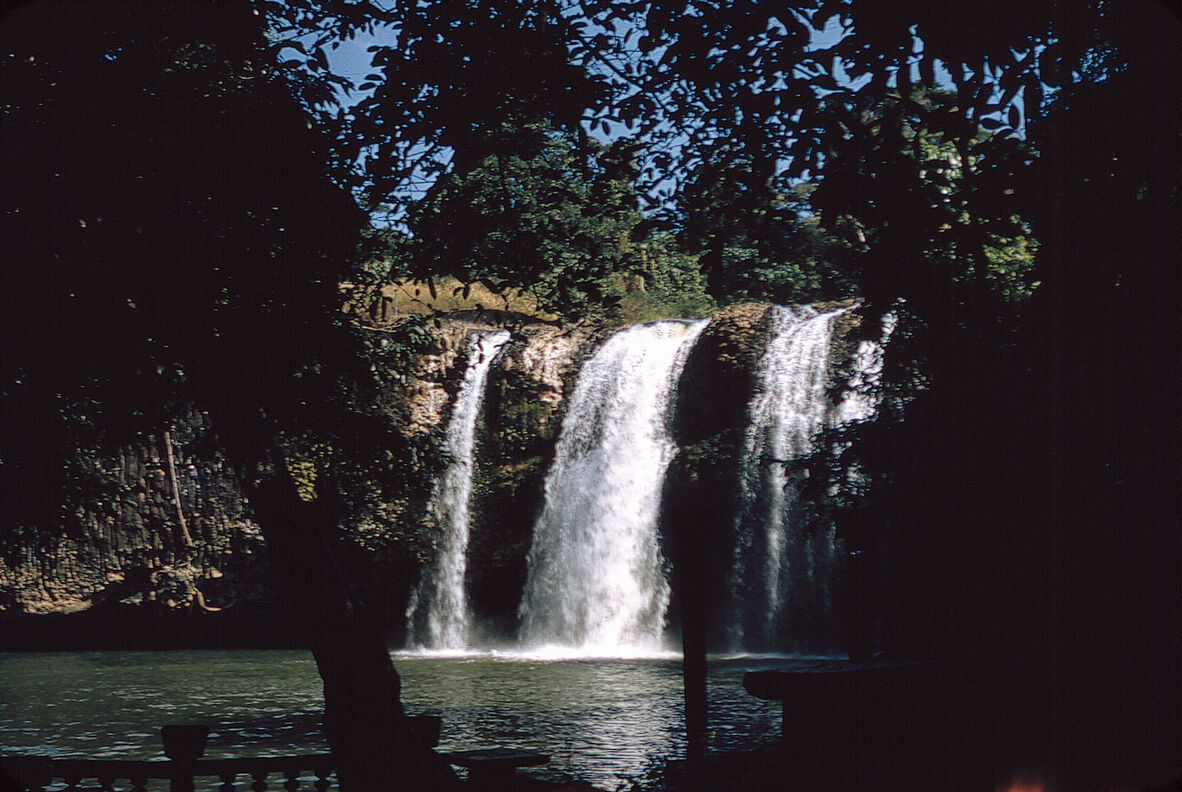
Mena Creek Falls at Paronella Park near Innisfail, 1955. 30612, Ledlie Family Colour Slides. John Oxley Library, State Library of Queensland Image number: lbp00125
Paronella Park: One man’s dream to build a castle in the North Queensland rainforest
Once the land was cleared and ready for building, José first constructed a home for his family, using materials from the surrounding landscape—sand and gravel from the creek, timber from his property, cement from Germany, and discarded railway tracks from cane farms. Hauling everything up 47 steep steps he built, he worked with only basic tools, shovels, picks, trowels, bush saws, wheelbarrows, and a cement mixer.
Inspired by the castles of Spain and the works of Antoni Gaudí, José envisioned Paronella Park as a place in harmony with the rainforest. He designed terraces, stairways, and buildings to blend with the rocky escarpment, drawing on Spanish Moorish gardens and the Café by the water in Madrid’s Botanic Gardens. His dream was to create an enchanting retreat with romantic castles, dark tunnels, bridges, and secret gardens.
The first major construction was a stairway linking two levels, followed by ornamental balustrades, picnic tables, and a café beside the water. He excavated clay for rendering while digging a tunnel to a small creek and waterfall. With remarkable energy, José and his workers soon completed the café, changing rooms, and toilet block.
His most ambitious structure was the grand hall, serving as a ballroom, cinema, theatre, and reception space. It featured a polished dance floor, ornate chandeliers, and North Queensland’s first private cinema, with a revolving mirror ball of 1,270 hand-cut mirrored facets casting shimmering light. The venue also housed an ice-cream parlour, café, bakery, and laundry.
By 1932, the park’s landscaping was complete. With advice from the Queensland Forestry Department, José planted 7000 trees, including the now-iconic avenue of Kauri Pines. Other trees included Maple, Hoop Pine, Bunya Pine, Silky Oka, Satin Ash, Walnut and Quandong. Beside preparing food for visitors, Margarita also developed a passion for tropical gardening, tending to the orchid and fern house.
Determined to make the park self-sufficient, José installed Queensland’s first private hydroelectric system in 1934. Inspired by hydroelectricity in Europe, he recognised the potential of Mena Creek Falls. With no formal training, he sought guidance from South Johnstone Mill engineers, who, impressed by his determination, helped him develop the system. Water flowed through an aqueduct onto a 30-foot drop, powering a turbine and DC generator from ex-army stock. The system supplied lighting, pumps, refrigeration, and cinema power. Damaged by flooding in 1946, it was later upgraded to AC power with local electrical technicians' help.
By 1935, Paronella Park was complete and officially opened on 5 July with a visit from Queensland’s Governor, Sir Leslie Orme Wilson. After a tour and morning tea prepared by Margarita, he remarked to journalist:
José Paronella has created a place of beauty that will be a great attraction for visitors in the future. His buildings are of unique design. The park is a credit to North Queensland. It is absolutely remarkable to see what one enterprising man can do.
Paronella Park quickly became a beloved destination, offering visitors the chance to swim, explore the gardens, play tennis or bowls, dine by the water, or dance in the grand ballroom—fulfilling José’s vision of an enchanting pleasure park.
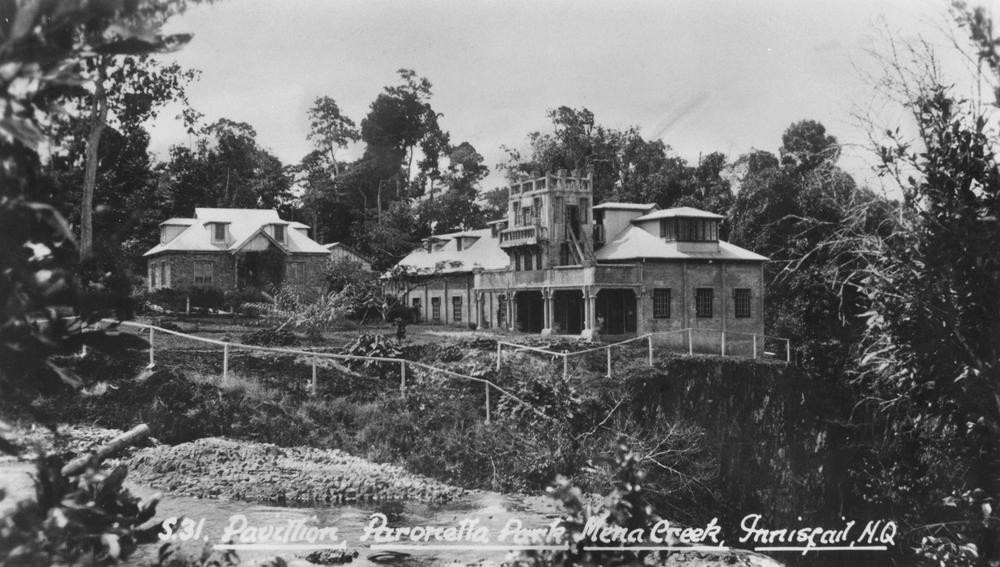
Pavillion at Paronella Park, Mena Creek, Innisfail, ca. 1935. John Oxley Library, State Library of Queensland, Negative number: 42062
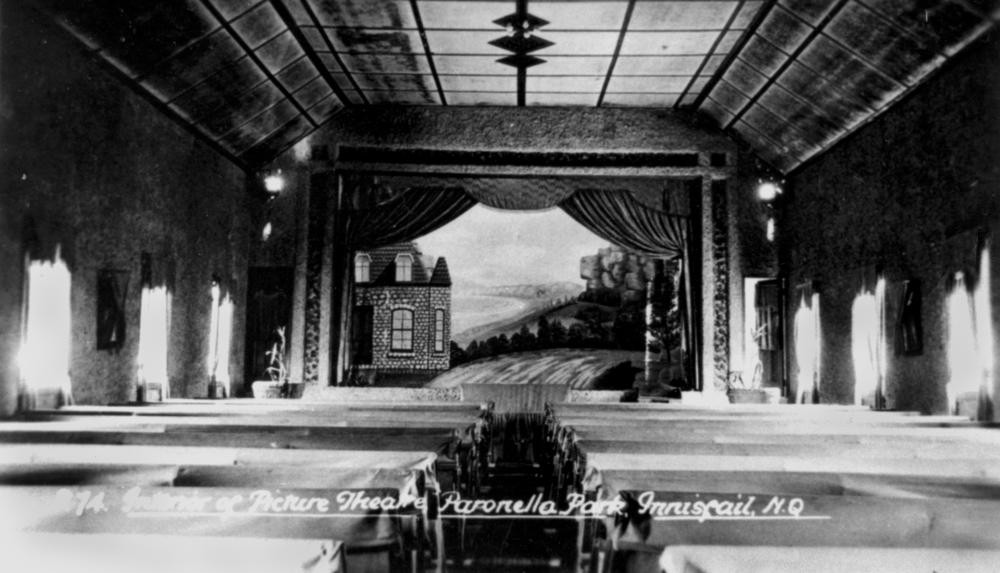
Interior of the picture theatre at Paronella Park, Mena Creek, Queensland, ca. 1937 John Oxley Library, State Library of Queensland, Negative number: 178078

View of the pavilion building from the upper garden terrace at Paronella Park, Mena Creek, Innisfail, August 1935. John Oxley Library, State Library of Queensland, Negative number: 64743.
Flick through more historic photos from State Library's collection below:
A compilation of home movie footage related to Paronella Park from State Library of Queensland's collection:
- Clip 1: 31306/18 Land of Magic, Paul Ruckert collection, John Oxley Library, State Library of Queensland.
- Clip 2: 31650 W. & F. Smith motion pictures, John Oxley Library, State Library of Queensland
- Clip 3: 32433/7 carne Westley, George Vardas films, John Oxley Library, State Library of Queensland
- Clip 4: 32845/4, A Tropical Wonderland, Nicko Productions home movies, John Oxley Library, State Library of Queensland
Take a look through photos of Paronella Park as it stands in 2023.
The park was not initially very profitable as it required constant upkeep the keep out the encroaching jungle and maintain the buildings in good condition. The Paronellas relied on Jose's other business interests to keep them afloat. With the outbreak of World War II and particularly the Pacific campaign after Pearl Harbor there was an influx of military personnel into the area including large numbers of Americans. Paronella Park was ideally located to take advantage of the need for R&R of all these soldiers. The carpark was soon full of military vehicles. To the war-weary servicemen the Park with its Spanish Castle and exotic gardens growing out of the rainforest must have been an astonishing sight and the park was busy throughout the war.
After the war there was a boom in interstate tourism and the park continued to prosper but in 1946 disaster struck. A cyclone brought torrents of rain, not unusual in the wettest part of Australia but this time there was a dangerous development. Upstream a large pile of cedar logs were awaiting transport near the creek. The rising flood carried the logs away and they formed a jam against the railway bridge upstream from the park. Eventually the bridge gave way and the flood of water loaded with huge logs rushed towards the park. Concrete balustrades and tables were uprooted and the cafe was flooded and ruined. The flood waters covered the upper gardens, rose to window level in the Hall, sending cedar logs crashing through into the foyer, the kitchen, the ballroom. One log tore a huge hole in the western wall and a section of the ballroom parquetry floor caved in.
Rebuilding work started but the cafe by the pool had to be abandoned. The hydro-electric system had to be repaired and the generator was replaced. The park was closed for six months and it was years before the flood damage was finally repaired. At the same time Jose was becoming obviously unwell and was diagnosed with stomach cancer.
José Paronella passed away in August 1948, leaving his wife Margarita, daughter Teresa, and son Joe to carry on his vision. Teresa later moved to Brisbane with her husband, while Joe married Val in 1952. Together, they had two sons, Joe (José) and Kerry, and worked tirelessly to maintain and renovate the Park. The floods of 1967, ’72, and ’74 added to their challenges. After Margarita's passing in 1967 and Joe's in 1972, Val and their sons continued the family’s hard-working tradition.
In 1977, the Park was sold out of the family by José's grandsons. A fire in 1979 severely damaged the Castle, leading to its temporary closure. Further setbacks came with Cyclone Winifred (1986), a flood (1994), and Cyclones Larry (2006) and Yasi (2011).
Mark and Judy Evans purchased Paronella Park in 1993, determined to restore its legacy. Rather than rebuilding, they focused on preserving and maintaining the site, uncovering pathways, enhancing the Museum, and undertaking small restoration projects. A major milestone came in 2009 with the $450,000 restoration of the Park’s original 1930s hydro-electric system, making it self-sufficient in electricity. The system now powers visiting electric vehicles, something even Jose could have never imagined. These and other eco-friendly initiatives led to Paronella Park receiving Eco Australia’s GECKO Award for Ecotourism in 2011.
The park is now heritage listed, recognised as a National Trust site in 1997 and added to the Queensland Heritage Register in 1999. Since then, Paronella Park has earned multiple Regional and State Tourism Awards. Today, it continues to welcome visitors, hosting social gatherings and weddings, keeping José’s dream alive.
Much of the information in this article comes from the biography of Jose Paronella, The Spanish Dreamer by Dena Leighton (photo below) and expanded from an original State Library blog by Simon Miller.
State Library holds a range of historic material on Paronella Park, including a rare souvenir booklet (photo below). You can explore what's available through our OneSearch catalogue.
Troy Keith
Queensland Memory
References
-
Leighton, D. & Hutton, L. (2007) The Spanish dreamer : a biography of Jose Paronella / by Dena Leighton ; edited by Lynne Hutton. [Rev. ed.]; revised by Paronella Park 2007. Mena Creek, Qld: Paronella Park.
-
1935 'TRIBUTES TO PARONELLA PARK', Johnstone River Advocate and Innisfail News (Qld. : 1928 - 1941), 5 July, p. 1.
-
1948 'DEATH JOSE PARONELLA IN HOSPITAL', The Evening Advocate (Innisfail, Qld. : 1941 - 1954), 23 August, p. 1.
-
1952 'A Spanish castle in the Australian bush', The World's News (Sydney, NSW : 1901 - 1955), 22 November, p. 16.
-
Sam Nichols and Chris Bullock, 2024 'The Castle in the Trees', ABC Sunday Extra, 2 March 2024.
-
Paronella Park official website: www.paronellapark.com.au
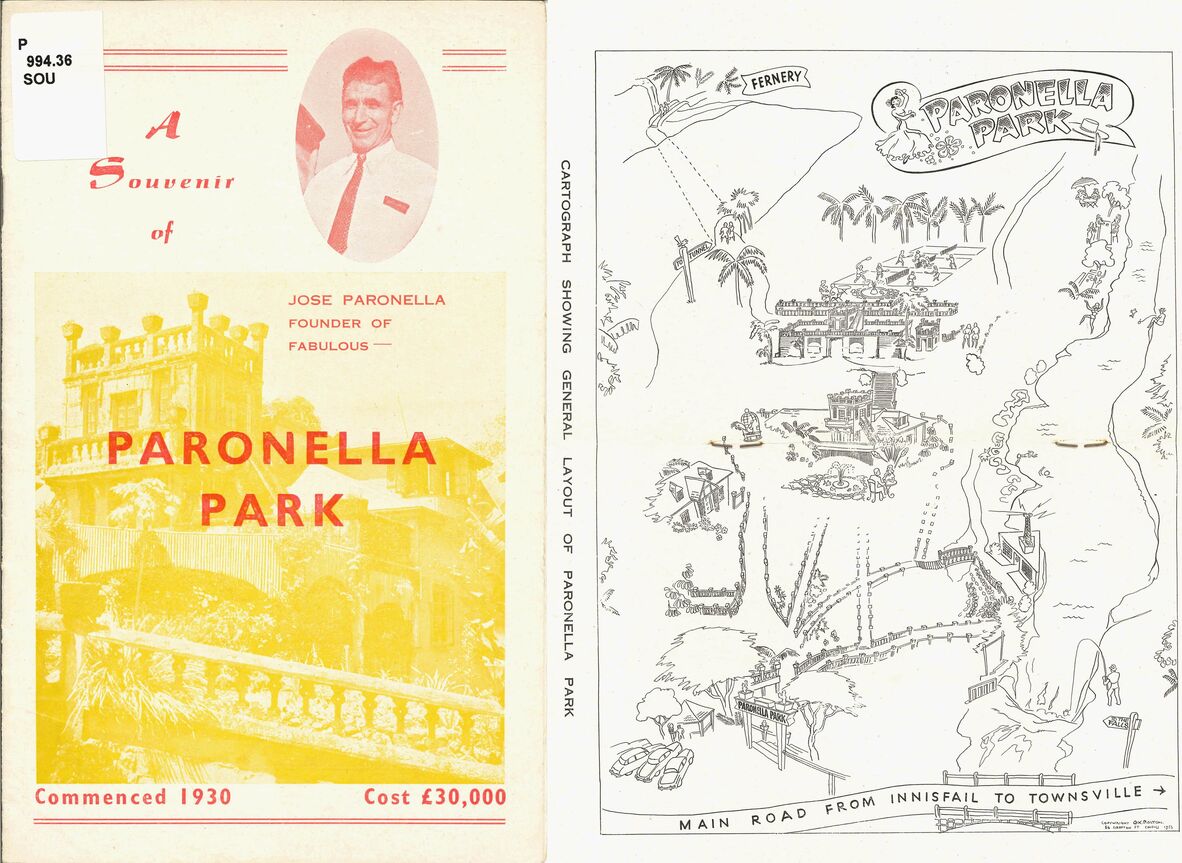
Anon (1953) A souvenir of Jose Paronella, founder of fabulous Paronella Park. Cairns, Qld: G. K. Bolton. John Oxley Library, State Library of Queensland.
The Spanish dreamer : a biography of Jose Paronella / by Dena Leighton. John Oxley Library, State Library of Queensland.
Comments
Your email address will not be published.
We welcome relevant, respectful comments.
